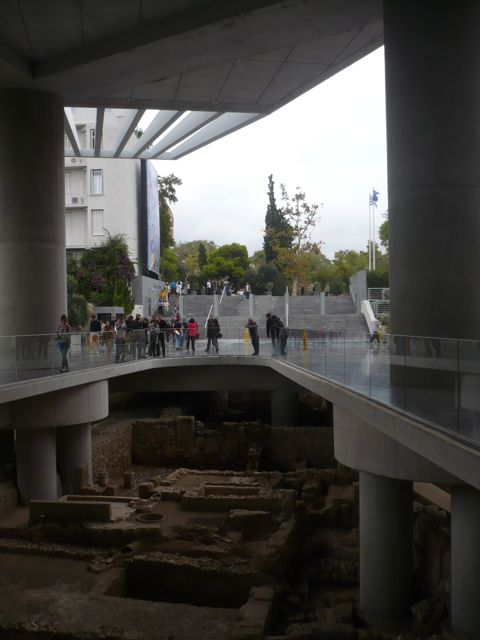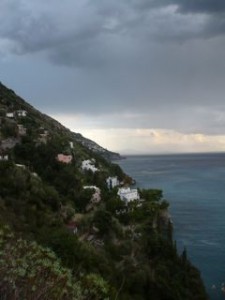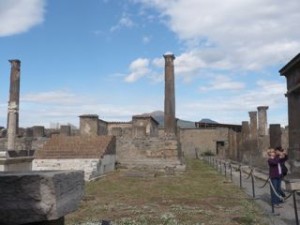S’agapo: It means I love you
S’agapo was the first Greek phrase we learned on the Greece Study Trip 2011 and also reflects the warm feelings I had for Greece upon my departure from the country.
Between travel, midterms, and trying to get the most out of being in Rome this has been a very busy semester. Fall break was a welcome reprieve and I was excited to get out of Rome for a while to embark on the longest trip (10 days) out of Italy that I will be taking this semester. During study trip sign-up at the beginning of the semester there was a lot of controversy over the Greece trip: would it be worth the money? But after this experience I can say that this trip is definitely worth it. It was really nice that all the transportation and hotels were prepaid and everyday we had at least one group meal included. The meals were ridiculously good and consisted of multiple courses… and unlimited wine. I was really excited to have some new cuisine outside of the pasta and pizza that I eat day in and day out in Rome. Plus, gyros are awesome, especially in their place of origin. I also feel like the trip allowed me to see the different sides of Greece because we went from the city (Athens) to towns (Delphi, Nauplio), to even smaller towns (Karyes), and to some islands (Spestes, Hydra). Attempting to see these locations would have been very difficult without this study trip. Also, although I am not really a museum person, I liked how at each site we got to go in the accompanied museum and see some of the artifacts that were removed from the site. Our guide also didn’t try to make us stay too long at each museum either; we would hit up the highlights with 15-20 minutes of free time and head out on the next leg of our journey. Since this trip was so long, I don’t think I would be able to describe what we did each day in detail (nor would you want me to) so I’ll just give a couple highlights from each city/ island that we visited.
Also, it is definitely necessary to mention that the current political situation in Greece is very tumultuous. Many of the cities have recently been hit by a series of strikes and protests. I have never witnessed first-hand a situation like this before; many of our travel plans were impacted by the strikes and I saw a couple protests during my time in Greece. It was a little stressful to be unsure of what was going on or whether we would be able to reach all of our planned destinations but luckily the leader of the trip, Ioanna, was able to amazingly adapt our plans whenever any obstacles appeared.
Athens:
We began our trip to Greece in Athens. Our hotel was walking distance from the Acropolis and Parthenon. I learned that the Acropolis is the hill and the Parthenon is the specific structure dedicated to the God Athena. Unfortunately, we were not able to see the Parthenon up close because that area was closed off due to the strikes but we did see it from the bottom of the Acropolis. We also so got to go to the newly built Acropolis museum, where we saw a lot of the artifacts. I was really glad we got to go into this museum because it made up for not seeing the actual Parthenon up close. The museum was built to mirror the orientation of the Parthenon and houses a lot of the relief sculptures so I still got a good idea of the site. Another interesting point about this museum is that when they stared excavating the land to lay the foundation, they found the ruins so the whole museum is built on stilts above the ruins. There are also clear glass floors in sections of the museum that allow you to see down under into the ruins that they are presently still in the process of excavating.
There was also a market in the area around the Acropolis that was a little tourist-y but it was fun to walk around all of the stores in the area. Some of my friends even got fake Ray-Bans that only cost 5 Euros.

Delphi:
We only stayed in Delphi for one night but it was in a really pretty location among the mountains. Being so high up did mean that it was pretty cold however, and I was really glad that I decided to bring my Northface. Apparently, Delphi is a really big skiing area in Greece. There was even snow on the top of some of the higher, neighboring mountains. Overall, Greece had a lot more hills/ mountains that I expected; many more that even Italy. We went to the ruins of the Oracle of Delphi, which I was excited to see, especially since we had just watched the movie 300 on the bus ride to the site.
Nafplion:
On the way to Nafplion, we stopped at Epidaurus Theater. It is an outdoor amphitheater that seats 17,000 with amazing acoustics. You can hear a coin drop or a piece of paper rip from the top of the seats. I was really impressed to learn that scholars today still do not really know what makes the sound travel so clearly. Nafplion was a really pretty city. It was really clean and well kept (especially compared to the piles of trash laying around in Athens due to the strike). My favorite thing we did in Nafplion was climbing all 999 steps up to the Palamidi Castle. It was definitely a work out but not as bad as I expected. There was a great view of the city and harbor from the castle. From the castle you can also see that the city below is laid out in a grid pattern, which is really unusual for old towns like this.

Karyes:
The leader of our trip’s family was from Karyes so we stopped there after a wine tasting during the day. The town was really small and is based on agriculture so on the way there were a bunch of goats blocking the road. The village is also located on the land that was formerly part of Sparta. Looking around at the surrounding countryside, I tried to imagine what it was like in Spartan times. The people of ancient Greece must have been really resourceful to have been able to transverse such hilly terrain. Before leaving the town I got to try some Greek coffee (delicious) and homemade donuts (extra delicious!).
Spetses:
After the day trip to Karyes, the original plan was to stay in Mykonos for the rest of the trip. The boats were on strike, however, so we ended up going to a much closer island, Spestes, instead. This was disappointing at first, but Spetses was really beautiful. We mostly just walked around and hung out at the beach, which was fine by me after so much busy traveling. We also rented bikes for a day and rode around the island, which was a really fun way to get around.
Hydra:
On the last full day in Greece we went to Hydra. It was about and hour and a half boat ride away from Spetses. It was super small and there aren’t even any cars on the island- the main form of transportation is donkeys! We walked around a little bit when we got there and then headed straight for the beach. There aren’t normal sand beaches many places in Greece, but there are rock ledges on the side of islands where you can sit of lay out. Then there is just a ladder that goes down into the water. This was a really cool change of scenery. The water was so blue and crystal clear! I tried to take pictures but they really can’t even begin to show how insanely beautiful the scenery is in person.
Overall I gained so many great memories in Greece. Greece felt like the most foreign place that I have visited so far. Mostly because they use a different alphabet so I had no chance of reading any signs, but also because they were ruled by the Ottoman Empire for a long time so Middle Eastern culture has had an effect on the area. It was cool to see mosques and more European architecture all in the same plazas.
This week is turning out to be a busy one with another midterm and lots of reading to do for class, but I’m already getting excited for next weekend. It will be my second weekend in Rome- I can’t wait to explore the city some more!



